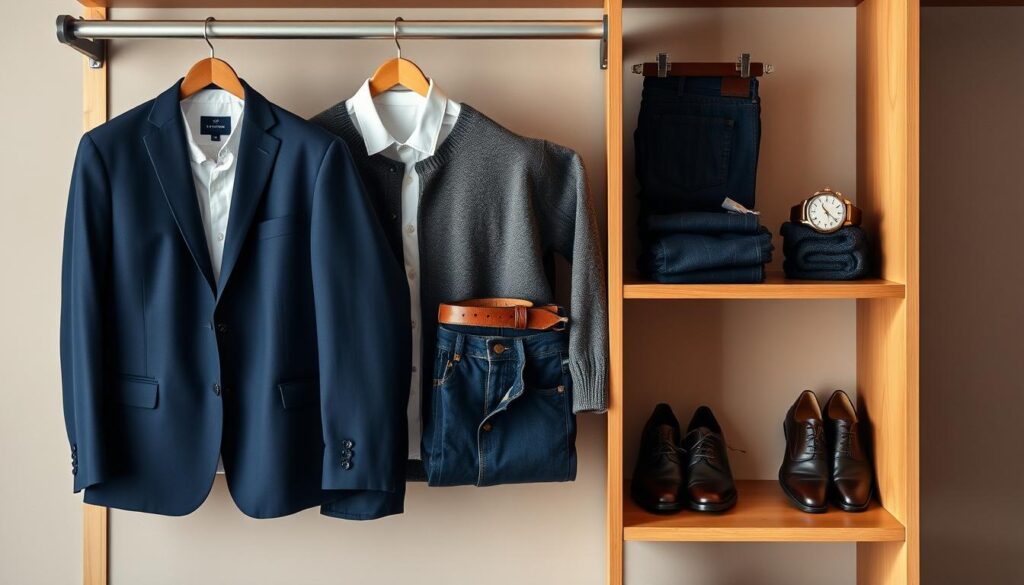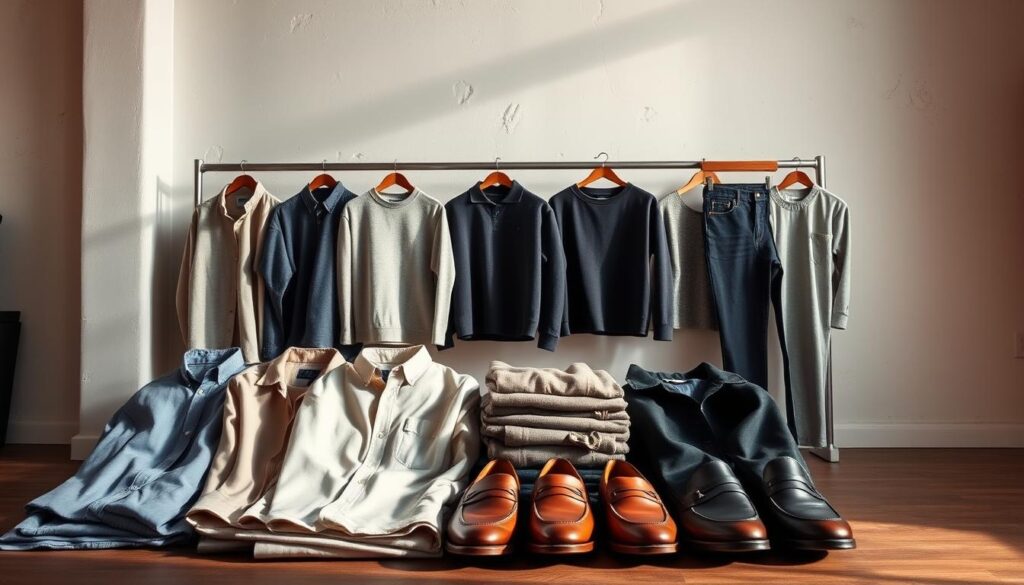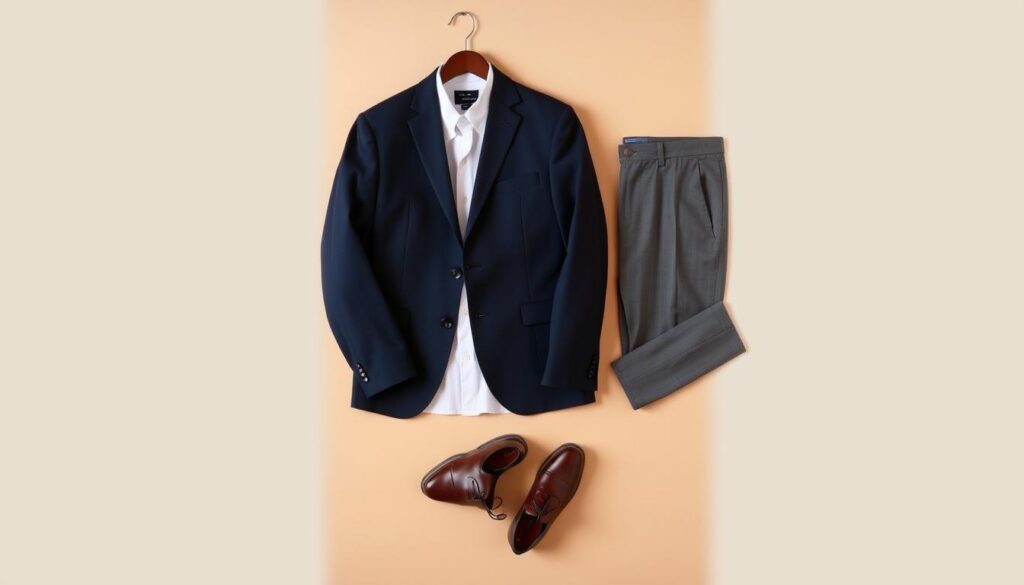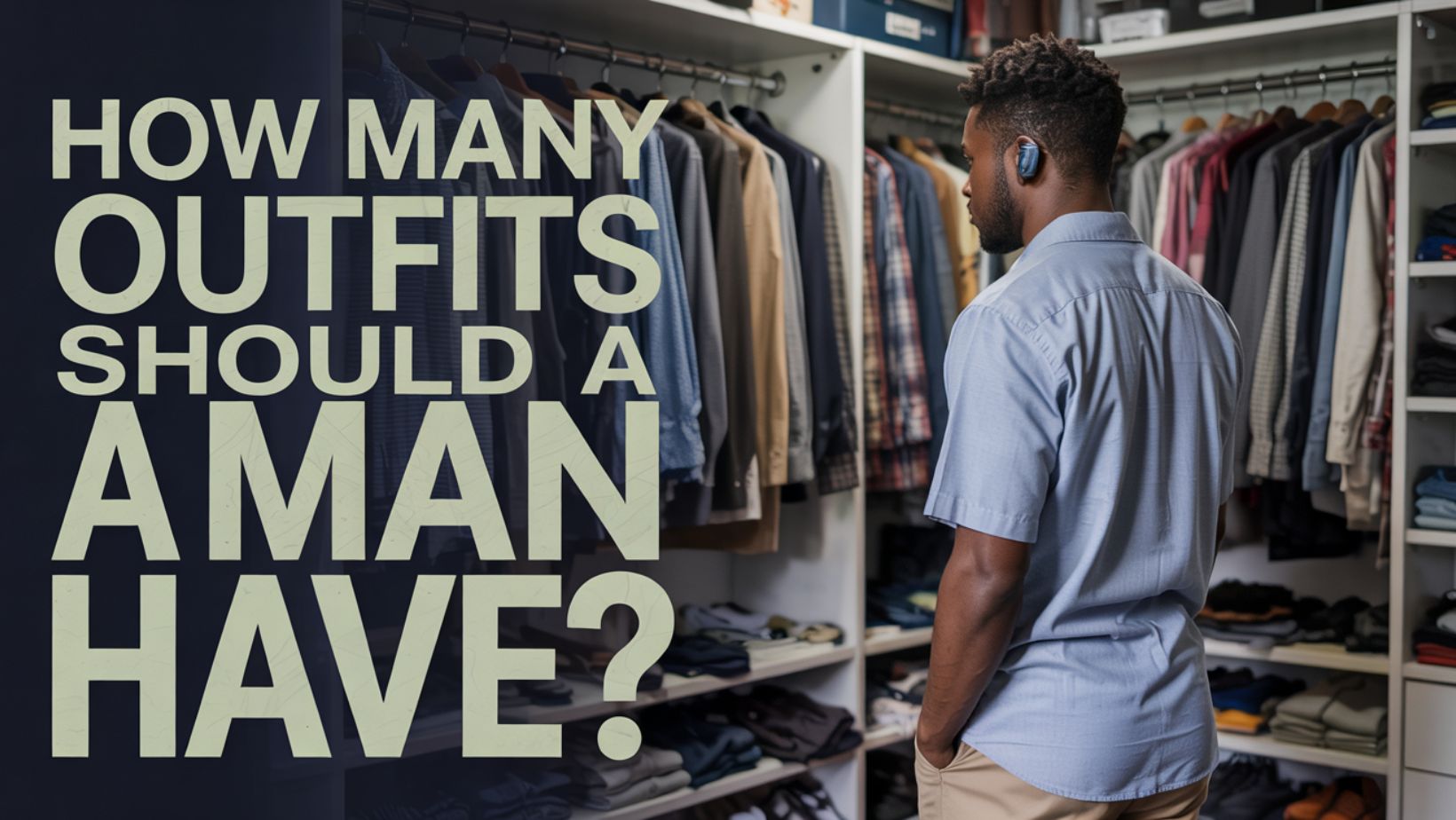Imagine your closet is full, but you still can’t find anything to wear. This problem isn’t just about numbers. It’s about finding the right balance between looking good and being practical. Fast fashion tells us to buy more, while sustainability says own less. This article will help you build a wardrobe that fits your life, not hinders it.

Forget trying to guess what to wear. Learn to focus on men’s wardrobe staples that give you endless choices. We’ll show you that having fewer, but better, pieces can make you look great every day.
Key Takeaways
- Outfit count depends on lifestyle, not just fashion trends.
- Men’s wardrobe staples form the foundation of versatile dressing.
- Quality pieces reduce the need for constant shopping.
- Sustainability starts with intentional clothing choices.
- Style confidence comes from curation, not quantity.
Understanding Your Wardrobe Needs
Building a functional wardrobe starts with knowing your daily life. Your job, hobbies, and where you live all affect what you wear. Let’s explore how to match your closet to your lifestyle.
Lifestyle Factors That Determine Wardrobe Size
Your career and hobbies are key. Office workers might need formal clothes, while those who love the outdoors want durable items. Here’s a checklist:
- Career: Formal suits or casual clothes?
- Climate: Layering for changing seasons.
- Activities: Gym clothes, travel items, or outfits for special events.
The Difference Between Outfits and Individual Pieces
Outfits are complete looks. Pieces are the building blocks. Mixing basics can create many outfits:
| Outfits | Individual Pieces |
|---|---|
| Business meeting ensemble | White shirt, navy blazer |
| Date night outfit | Jeans, dress shoes |
Two essential men’s fashion essentials like a classic trench coat or tailored chinos can fit into many outfits.
Finding Your Personal Style
Define your style with these steps:
- Choose 2-3 core colors (navy, black, gray).
- Get well-fitting jeans and timeless shoes.
- Add a bold accessory to make a statement.
Focus on creating a versatile wardrobe for men that grows with you, not with trends.
The Minimalist Approach: Less Is More
Creating a stylish men’s wardrobe doesn’t need hundreds of items. The minimalist way is about quality over quantity. It turns your closet into a collection of essential pieces.
By following the 80/20 rule, you find the 20% of items you wear most. This rule helps you focus on what’s important. It reduces clutter and makes choosing outfits easier.
- Focus on wardrobe basics for men like neutral-toned shirts, tailored trousers, and timeless outerwear.
- Replace duplicates with multi-functional items that mix and match effortlessly.
- Invest in high-quality fabrics and classic designs that last through seasons.
| Essential Item | Uses |
|---|---|
| White T-Shirt | Under blazers, casual outings, layered under sweaters |
| Dark-Wash Jeans | Casual weekends, smart-casual dinners, weekend trips |
| Neutral Blazer | Office meetings, date nights, formal gatherings |
“A minimalist wardrobe reduces stress and amplifies confidence,” says Style Theory, a men’s fashion publication tracking trends since 2010. “Men who streamline their choices report spending 40% less time getting ready daily.”
Building a stylish men’s wardrobe means investing in quality brands. Look for basics at Uniqlo or sustainable outerwear at Outerknown. With 5-7 core pieces and 2-3 statement accessories, you can create many outfits. Minimalism is about making intentional choices that show your style without being too much.
Essential Clothing Items Every Man Should Own
Building a great wardrobe starts with the basics. These men’s clothing essentials are key for mixing and matching. They ensure you look good without overdoing it. Quality fabrics and classic designs make these essential clothing pieces for men last for years.
Tops: T-shirts, Button-downs, and Sweaters
Begin with basics that fit any occasion:
- T-shirts: Have 5-7 neutral-colored cotton or cotton-blend ones. Add 1-2 graphic styles for casual days.
- Button-downs: Get 2-3 in crisp white, light blue, or striped patterns. They’re great for work or weekend layering.
- Sweaters: Choose 1-2 merino wool or cashmere styles in navy or charcoal. They’re perfect for fall and winter.
Bottoms: Jeans, Chinos, and Shorts
Opt for durable pieces that go well together:
- Jeans: Have 2-3 pairs: dark wash, black, and a mid-tone for versatility.
- Chinos: Pick navy or gray chinos from brands like J.Crew or Uniqlo. They’re great for smart-casual looks.
- Shorts: Get 1-2 pairs of denim and linen for warm-weather comfort.
Outerwear: Jackets and Coats
Protect and style with these key pieces:
- Bomber jackets for casual outings.
- Trench coats for rain and style.
- Leather jackets or pea coats for seasonal layering.
Footwear Essentials
Invest in shoes that last:
- Sneakers: A classic pair like Nike Air Max for daily wear.
- Dress shoes: Oxfords or loafers from Cole Haan for formal events.
- Boots: Waterproof styles like Timberland for outdoor use.
Mixing these items thoughtfully creates many outfits. Focus on timeless fabrics and neutral tones for maximum wearability. Remember, less is more when every piece has multiple uses.
How Many Outfits Should a Man Have for Different Occasions
Choosing the right number of outfits depends on your lifestyle and priorities. Let’s break it down by occasion to find your balance:
- Formal events: 1–2 sharp suits cover weddings, job interviews, or black-tie gatherings. Prioritize versatile styles like navy or charcoal gray.
- Business casual: 3–5 outfits work for most offices. Pair tailored chinos with blazers or crisp button-downs.
- Weekend wear: 4–6 relaxed looks for errands or casual hangs. Opt for denim, hoodies, and breathable tees.
- Active wear: 2–3 sets of moisture-wicking gear for workouts or outdoor activities.
- Special occasions: 1–2 standout pieces like a tuxedo or bold jacket for rare events.
“A well-curated wardrobe isn’t about quantity—it’s about intentional choices.”
Focus on must-have clothing items for men that mix and match. For example, one navy suit paired with different shirts or ties adapts to multiple events. Prioritize quality fabrics and timeless cuts so outfits last longer. If you travel often, pack 2–3 versatile layers instead of duplicates. Remember: the goal is to feel confident without overwhelming your closet.
Building a Versatile Work Wardrobe
Creating a versatile work wardrobe means you’re prepared for any work setting. It also keeps your closet organized. Focus on men’s wardrobe staples that fit meetings, client calls, or casual days. Choosing quality over quantity makes your wardrobe both useful and fashionable.
Business Professional Attire
For formal jobs, get 3–5 suits in navy, charcoal, or black wool. Match them with 5–7 dress shirts in white, light blue, or soft pastels. Include 2–3 silk ties and leather oxfords. Stick to neutral colors to easily mix and match.
Business Casual Essentials
For business casual, get 2–3 blazers in tweed or herringbone. Add chinos, dress pants, and knitted sweaters for texture. Choose 4–5 button-down shirts and leather loafers. This mix is perfect for client lunches or team meetings.
Remote Work Considerations
For video calls, wear tops that look good on camera, like tailored blazers or pressed oxfords. Wear comfortable bottoms like chinos or dark jeans at home. Use a uniform style, like navy and gray, to save time and stay professional.
Creating a Weekend and Casual Wardrobe
Weekend style doesn’t have to mean sacrificing taste for comfort. A well-thought-out weekend wardrobe mixes practicality with personality. Begin by selecting men’s fashion essentials that work for everything from hikes to dinner.
- 7–10 casual t-shirts (opt for cotton or linen for breathability)
- 3–5 pairs of jeans or chinos (include one dark wash, one light denim, and a neutral chino)
- 3–5 weekend-appropriate button-downs (stripes, plaids, or solids)
- 3–4 casual sweaters or hoodies (mix knit textures and seasonal fabrics)
- 3–5 casual footwear options (sneakers, loafers, and boots)

“Casual doesn’t mean careless. A well-curated weekend wardrobe shows intention.” — GQ Style Guide
Adding elevated casual pieces like linen-blend polos or tailored joggers can elevate your look. Try pairing a crisp white shirt with distressed jeans for brunch. Or layer a lightweight sweater over graphic tees for a relaxed yet stylish look. Brands like Levi’s 501s or Patagonia fleece jackets are great for any setting.
Focus on neutral bases (beige, navy, gray) to make mixing and matching easy. Building a stylish men’s wardrobe for weekends means having pieces that work for different activities without being too complicated. Choose quality over quantity—invest in a versatile pair of chinos or a timeless bomber jacket. This way, you’ll feel confident whether you’re running errands or meeting friends, knowing each piece can be used in multiple ways.
Seasonal Wardrobe Planning
Planning your wardrobe by season keeps your closet tidy. Start by thinking about your climate and how often you’ll wear certain items.
Summer vs. Winter Essentials
Extreme weather means choosing wisely. For summer, go for wardrobe basics for men like cotton shirts, linen pants, and moisture-wicking tees. In winter, you’ll need thermal layers, wool sweaters, and insulated coats. Aim for 3-5 items in each category to meet your daily needs without clutter.
“Layering is the key to timeless versatility.” – GQ Style Guide
- Lightweight windbreakers for spring
- Mid-weight cardigans for fall
- Scarf-and-shirt combos for mild days
These items help you transition between seasons, so you don’t need to buy new outfits all the time.
Year-Round Staples
Invest in men’s clothing essentials that work in any weather. A navy blazer, chino pants, and neutral-colored t-shirts are key. They can be layered with seasonal pieces, making your wardrobe versatile and compact.
Store off-season items in vacuum-sealed bags to save space. Buy seasonal pieces during sales to save money and avoid buying on impulse.
The Role of Accessories in Multiplying Your Outfit Options
Accessories are key to making the most of your wardrobe without buying more clothes. The right ones can turn a few essential pieces into many outfits. Here’s how to use them wisely.
Essential Accessories Every Man Should Own
Begin with versatile basics. Look for:
- Watches: 1-3 styles (like a simple quartz or a rugged leather strap).
- Belts: 2-3 neutral colors (black, brown, dark brown) to match pants and jackets.
- Ties/pocket squares: 5-8 silk options in solids or subtle patterns for work.
- Sunglasses: 1 classic pair (aviator or wayfarer) and 1 sporty style.
- Scarves: 2-3 in wool or linen for layering through the seasons.
How Accessories Transform Basic Outfits
Start with a simple white shirt and navy chinos. Add a leather belt and a bold tie for a meeting. Change to a linen scarf and aviators for brunch. Accessory rotation lets you change the same outfit into 3-4 looks.
“The best accessories are those you forget you’re wearing—until they make your outfit.” — Tom Ford
Choose quality over quantity. A single cashmere scarf is cheaper than a new shirt but adds texture to 10+ outfits. Store accessories in clear bins or on hooks for easy access. Clean belts with a soft cloth and fold scarves flat to avoid creases.
Quality vs. Quantity: Investing in Your Wardrobe
Investing in well-made clothing pays off over time. High-quality pieces last longer and adapt to changing trends better than fast fashion. Think of must-have clothing items for men as smart choices for your lifestyle.

Look for durable fabrics like wool or cotton blends. Check stitching details—double-needle seams and reinforced stress points signal quality. Brands like Eton or Brooks Brothers build suits designed to last decades. A premium leather jacket from Columbia or a pair of Goodyear-welted shoes from Church’s might cost more upfront but outlive cheaper alternatives.
“A well-made garment is an investment in self-expression.” — , menswear stylist
| Category | Investment Pieces | Budget-Friendly Options |
|---|---|---|
| Suits | Three-piece wool blends | Weekend suits in polyester blends |
| Footwear | Oxfords from Church’s | Casual sneakers from Skechers |
| Outerwear | Barbour wax jackets | Puffer jackets from Uniqlo |
Storage Solutions and Organization Tips
Smart storage makes your versatile wardrobe work better. Organized spaces help you see what you have. This makes it easier to choose the right outfits without too much clutter. Here are some tips:
Maximizing Closet Space
- Hang vertically: Use slim hangers sets to double hanging capacity.
- Roll tees and polos to save drawer space.
- Stack folded items in labeled bins under beds or shelves.
Seasonal Rotation Strategies
Change your clothes every 3-4 months. Clean them before you store them. Use breathable bins or vacuum-sealed bags. Cedar hangers keep pests away. Rotating clothes helps you avoid buying too much, keeping your wardrobe balanced all year.
Maintaining Your Clothing
Regular care makes clothes last longer. Always follow the care labels. For shoes, brush them weekly and use conditioner. Fix rips early. Here are some key tips:
| Type | Care Tip | Benefit |
|---|---|---|
| Sweaters | Hand wash in cold water | Prevents shrinkage |
| Jeans | Wash inside out every 4-6 wears | Preserves color and shape |
| Blazers | Air out weekly | Reduces wrinkles |
Following these steps keeps your wardrobe in top shape. Less clutter means you only keep what you really need. This keeps your versatile wardrobe both lean and efficient.
The One-Month Wardrobe Challenge
Ready to redefine your style? Try the One-Month Wardrobe Challenge to uncover what truly works for you. This 30-day experiment helps men track their clothing use and preferences. It reveals the men’s clothing essentials they actually need.
- Pick 20-30 core pieces from your current wardrobe. Include versatile basics like neutral-colored shirts, trousers, and outerwear.
- Wear only these items for 30 days. Note which pieces you reach for most and which go unused.
- Track outfit combinations, jotting down moments you felt confident or wished for more options.
- At month’s end, analyze results to identify gaps and redundancies.
“I realized I owned 5 identical sweaters but lacked one good blazer. Now my building a stylish men’s wardrobe is 50% smaller but 100% intentional.” – Alex M., Challenge Participant
Use apps like Closetly or spreadsheets to log daily choices. Focus on how specific men’s clothing essentials perform in real life. By the end, you’ll know exactly which items fuel your confidence and which clutter your space.
This hands-on method replaces guesswork with data. It helps you create a wardrobe that mirrors your true style. Ready to stop overbuying and start wearing what truly matters?
Conclusion
So, how many outfits should a man have? It’s not about counting hangers. It’s about choosing pieces that fit your life. Think about what you need for work and play.
Start with basics like good t-shirts, jeans, and a blazer. These items can be mixed and matched easily. A well-planned wardrobe is all about these essentials.
Quality is more important than quantity. Spend on timeless items like a tailored coat or versatile sneakers. These pieces will grow with you, not against you.
Accessories like belts or watches can add style without needing new outfits. Regularly check your closet to see what you really need.
Style is a personal choice. Whether you like simple or bold, the right pieces let you show who you are. Choose fabrics that last, colors that go together, and fits that look good.
Confidence comes from knowing each item has a purpose. It’s not about filling space.
Begin with small changes. Swap one old item for something new. Add seasonal layers. Check your closet’s goals every few months.
Remember, your wardrobe should reflect your life. It’s not about following rules. It’s about being practical, purposeful, and personal. Your perfect number is a reflection of who you are today.
Frequently Asked Questions
How many outfits should a man have for different occasions?
The number of outfits a man needs depends on his social life. For formal events, 1-2 suits are good. For semi-formal, 2-3 smart-casual outfits work well. For work, 5-7 outfits based on the dress code are best.
For casual weekends, aim for 3-5 outfits that show your style. Add a few leisure pieces for fun. The goal is variety without too much clutter.
What are the essential clothing items every man should own?
Every man needs a few key items. Start with 5-7 t-shirts and 3-4 button-down shirts for different looks. Add 2-3 versatile sweaters for any weather.
For pants, 2-3 jeans, 2-3 chinos, and 1-2 shorts are good. Don’t forget a denim, leather jacket, and a coat for the weather. Shoes should include casual sneakers, formal shoes, and loafers for all occasions.
What factors should I consider when building my wardrobe?
Think about your lifestyle and style when building your wardrobe. Consider your work, social life, and what you like to wear. Also, think about the weather and events you go to.
Make sure your outfits can mix and match easily. Quality is more important than quantity for a lasting wardrobe.
How can I create a versatile wardrobe with fewer pieces?
Focus on quality basics in neutral colors for a versatile wardrobe. Choose items that work for both casual and formal settings. For example, well-fitted chinos and dressy sneakers.
Accessories like belts, ties, and hats can make basic outfits look great for different occasions. Aim for tops and bottoms that go well together to create more outfits.
Why is quality over quantity important in men’s fashion?
Quality over quantity means a wardrobe that lasts. High-quality clothes are made better and last longer. They fit better and are more comfortable.
Investing in key items like suits and shoes means you won’t need to buy them often. This saves money and space. Plus, quality clothes make you look better.
How can accessories help in expanding outfit options?
Accessories can change a basic outfit into something special. A good watch, stylish belts, and ties or scarves can make a big difference. They let you express your style without needing more clothes.
Accessories are a great way to add variety to your outfits. They’re a smart way to enhance your style without spending a lot.
What storage solutions can help maintain my wardrobe?
Use hangers for jackets and shirts, and drawer organizers for accessories. Shelves are great for sneakers. Seasonal rotation helps keep your closet tidy.
Store off-season clothes in bins or vacuum-sealed bags. Regularly clean out your closet to keep only what you need. This makes planning outfits easier.

